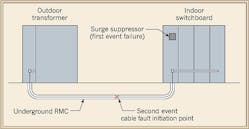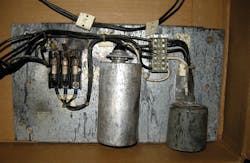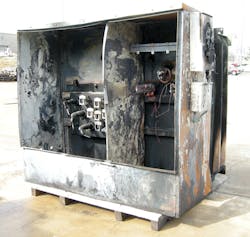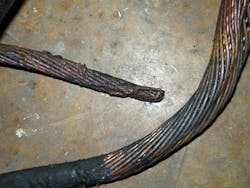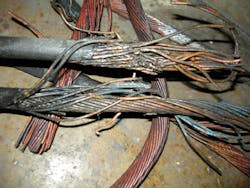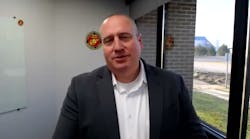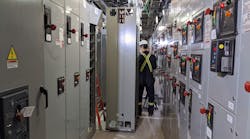It all began during a thunderstorm. Administrators at a high school noticed momentary power interruptions followed by smoke emanating from an electrical room, which housed the main power switchboard for the building. They immediately called the school district’s maintenance department, and the lead electrician responded.
Upon arrival, the school district electrician recognized that an abnormal event beyond his expertise had occurred within the switchboard, so he called in the help of an independent electrical contractor that had performed work for the school district before on its main service equipment. Electricians for that contracting firm opened the covers on the still-energized switchboard and found evidence of a failed surge suppressor mounted in its service entry section. That evidence included indications of dielectric oil ejections from the suppressor onto internal components of the switchboard, including copper bus bars and the insulation of the incoming power cables.
At that time, it was early afternoon on a Friday, so the contractor and school district personnel agreed that the switchboard could remain in service for a few more hours — until school recessed for the weekend. The electric utility was called to shut off power to the switchboard after teachers and students had left the building. The service entry setup at this school included a utility pad-mounted transformer that delivered 480/270V through approximate 20-ft lengths of underground rigid metal conduit, which served a 20-yr-old, 3,000A four-section switchboard (Figure).
Setting the stage
After utility personnel pulled the transformer’s primary side fusing to disconnect power, the contractor’s electricians removed the damaged surge suppressor from the switchboard along with its bus connection wiring (Photo 1). Next, they cleaned and inspected the switchboard interior. Based only on a visual examination of the equipment, they determined there was no damage to any of the switchboard’s internal components, including the bus bars, insulating parts, and visible ends of the incoming power cables.
The contractor believed the suppressor had failed due to exposure to a utility-side electrical transient or “surge,” possibly due to lightning activity. However, his crew did not test the power cables between the transformer and switchboard to determine the condition of the insulation hidden from view within the underground conduits. In fact, with the compromised suppressor fully removed and all visible contaminants successfully cleaned, the contractor’s lead electrician told the school district representative on-site that the switchboard could be returned to service. He did recommend obtaining and installing a replacement suppressor at a later date, given the fact that this was potentially a long lead time assembly due to the switchboard’s age. So that Friday evening, the electric utility crew was directed to re-energize the pad-mounted transformer.
The incident
During the de-energization process (prior to repairing the switchboard), the contractor’s electricians had opened the main breaker and all 22 downstream feeder breakers within that assembly. After the utility crew re-energized the transformer, the contractor performed voltage and phase checks at the switchboard connections. The contractor’s electricians then closed the switchboard’s main breaker and began reclosing the feeder breakers one at time, as school district personnel confirmed appropriate loads were being restored.
During this time, one of the contractor’s electricians began reinstalling the front covers on the switchboard service entry section. Just after closing one of the feeder breakers, a fault event resulted in an arc flash, sending a fire and pressure wave that emerged from the switchboard service entry section of the switchgear. The electrician, who was still installing covers, was positioned directly in the path of the blast. However, the large steel cover he was holding in front of his head and torso largely shielded him from the thermal effects of the event. Luckily, he was only knocked down, and suffered minor injuries.
At the time of this event, the utility crew had already closed up the transformer and left the site. The fault event also exhausted fire and a pressure wave into the transformer secondary side compartment, resulting in burning of insulating components, breaching of the transformer tank, and an oil-fueled fire that largely consumed that assembly (Photo 2). The initial fault event on the secondary side of the transformer was possibly terminated by opening of the transformer fuses, and utility primary side protective devices upstream of the transformer eventually opened.
Equipment examination and recovery
Examination of the switchboard after the second event did not reveal any fault damage — only accumulations of soot that were removed by cleaning procedures. The ends of the incoming power cables and their bus connection within the switchgear were found in similar condition. After the school district asked the switchboard manufacturer to inspect this equipment, one of its representatives determined that the assembly condition was satisfactory for short-term return to service. However, he indicated that it would need to be retired as soon as a replacement unit could be manufactured, shipped, and installed.
Examination of the transformer after the event revealed severe fire damage fueled by consumption of the oil tank contents. Observation of the primary and secondary side cable connections did not reveal any indications of significant fault damage. The transformer cabinet doors had been deformed by pressure buildup within the enclosure.
To restore power to the school as soon as possible, the electrical contractor worked overtime all weekend to fully clean the switchboard and replace the underground power cables and conduits. During that time, the utility installed a replacement transformer, and power was restored to the school before Monday morning.
Engineering evaluation
I was retained by the insurance carrier for the school district to evaluate the accident and visited the school the week after the incident. The information documented above is based on statements made by involved personnel as well as photographs taken by the electrical contractor.
The switchboard exterior conditions appeared normal for a 20-yr-old installation, but (for safety reasons) I declined to examine the interior in an energized condition — because it had been exposed to a fault event. Plans were made with the school and the insurance client to perform that exam at the time of planned replacement of the switchboard approximately one month later.
The surge suppressor removed from the switchboard exhibited failure conditions typical of age and accumulated stress from exposure to multiple transient events. The cables and the transformer (inspected at a utility storage yard) exhibited the damage described above.
The equipment conditions observed and reported clearly indicated the event initiated with faulting near mid-length of the power cables while the switchboard loads were being reconnected. I determined that following the initial surge suppressor failure event, the cable insulation was probably in a compromised condition due to a combination of age and exposure to the various transient events, which eventually caused the suppressor failure. I further reported that had the electrical contractor performed insulation integrity testing prior to re-energizing the installation — after recovery from the initial suppressor failure event — the cable’s degraded insulation conditions would have likely been detected. This should have led to cable replacement and prevention of the second more severe and dangerous fault occurrence.
The failure to test and then replace the distressed power cables after the suppressor failure led to much more costly damage. This included replacement of the utility transformer, excavation, and replacement of the underground conduits — and eventual replacement of the switchboard. In addition, the electrical contractor was extremely fortunate that one or more of its electricians did not suffer severe arc-flash injuries due to the occurrence of the secondary fault event. This, in part, was due to their failure to fully install all switchboard covers prior to reconnecting loads to the switchboard.
Codes & standards
The specific editions of the codes and standards in effect at the time of the accident include:
- The American National Standard Recommended Practice for Electrical Equipment Maintenance, 2006 Edition (NFPA 70B) indicates that preventive maintenance, including electrical testing of insulation, is the best way to ensure continued reliable service from electrical cable installations. Further recommended is a testing interval of one to three years (reference Chapter 11 and Appendix I).
- The American National Standard for Maintenance Testing Specifications for Electrical Power Equipment and Systems (ANSI/NETA MTS-2007) specifies that low-voltage (600V maximum) power cables in service should be tested for insulation resistance every 36 months. The specification calls for testing the cables for 1 min. at 500VDC (reference Sec. 7.3.2.2.2 and Appendix B).
- The American National Standard for Electrical Safety in the Workplace, 2009 Edition (NFPA 70E) specifies that current-carrying conductors shall be maintained to conduct rated current without overheating, and their insulation integrity shall be maintained to support the voltage impressed (reference Secs. 210.3 and 210.4). In addition, Chapter 1 of this standard requires a hazard analysis when performing work within the arc flash protection boundary of energized equipment.
Litigation
During depositions, the electrical contractor’s representative stated that the firm did not advise the school district to have electrical tests performed on the cables between the transformer and the switchboard after the surge suppressor failure event. Why? Because they felt the recovery time delay and costs to perform the tests weren’t merited. The contracting company did have the test equipment and trained personnel needed to perform those tests.
In rebuttal, an independent experienced electrical contractor (retained as an expert by the school district insurer) testified that the “standard of care” for electrical contractors was to perform insulation resistance testing when circumstances (such as the failed switchboard surge suppressor) indicate the insulation on the incoming power cables may have been stressed. School district maintenance personnel testified that the cables powering this switchboard had never been electrically tested since their original installation; the electrical contractor representative’s testimony indicated they were aware of this situation.
The electrical contractor’s failure to recommend or perform cable testing was not in accordance with the standardized practices specified in the American National Standards listed above with regard to proper maintenance activities and safety. The lawsuit eventually settled before going to trial, with the electrical contractor and its insurance carrier paying a significant portion of the damage recovery costs resulting from the secondary fault event. These damages were in excess of the original fees invoiced by the electrical contractor.
Lessons learned
Electrical professionals can learn many things from this case. For starters, electrical maintenance contractors in today’s environment need to be prepared to completely inspect and test malfunctioning or damaged equipment they are requested to service for any hidden conditions that may affect safety or reliability.
When an electrical fault, transient, or surge occurs, it should be assumed that all current-carrying conductors and insulation systems in the event path may have been distressed, until proven otherwise by appropriate evaluation techniques. If there is a concern that any additional inspection or testing needed to assure that no problems exist may strain the customer’s cost constraints, then the contractor needs to fully explain why the additional evaluation is needed. This explanation should include not only the fees for that extra work, but also the possible costs (including safety risks), if a failure occurs due to an undiagnosed weakness in the electrical equipment.
The contractor should not assume any special knowledge on the part of the customer nor expect that customer to request additional evaluation service, even if they have their own staff electricians. If a customer should refuse evaluation work needed to assure equipment safety, then the contractor should document the situation in writing — and refuse to re-energize the equipment if significant hazard potential exists. In situations where life safety is at risk, the contractor may need to involve the local inspection authority for proper resolution.
In the example presented in this article, the electrical contractor failed to take the extra steps needed to assure the safety and integrity of equipment it had been charged with restoring. The testimony of the contractor’s employees indicated they were less than fully cognizant of the applicable industry standards addressing the need to verify integrity of electrical cable insulation at appropriate intervals. But instead of taking the opportunity to provide and bill its customer for an additional valuable service, this contractor ended up entangled in litigation that resulted in probable significant negative impact to its bottom line and reputation. The electrical contractor was also fortunate that allowing its employee to perform work in front of an open energized switchboard cabinet did not result in a tragic injury or fatality when the arc flash event occurred.
Shiver is a registered professional engineer in nine southeastern states. He serves as president of the consulting firm Chris Shiver, P.E. LLC in Roswell, Ga. He can be reached at [email protected].

